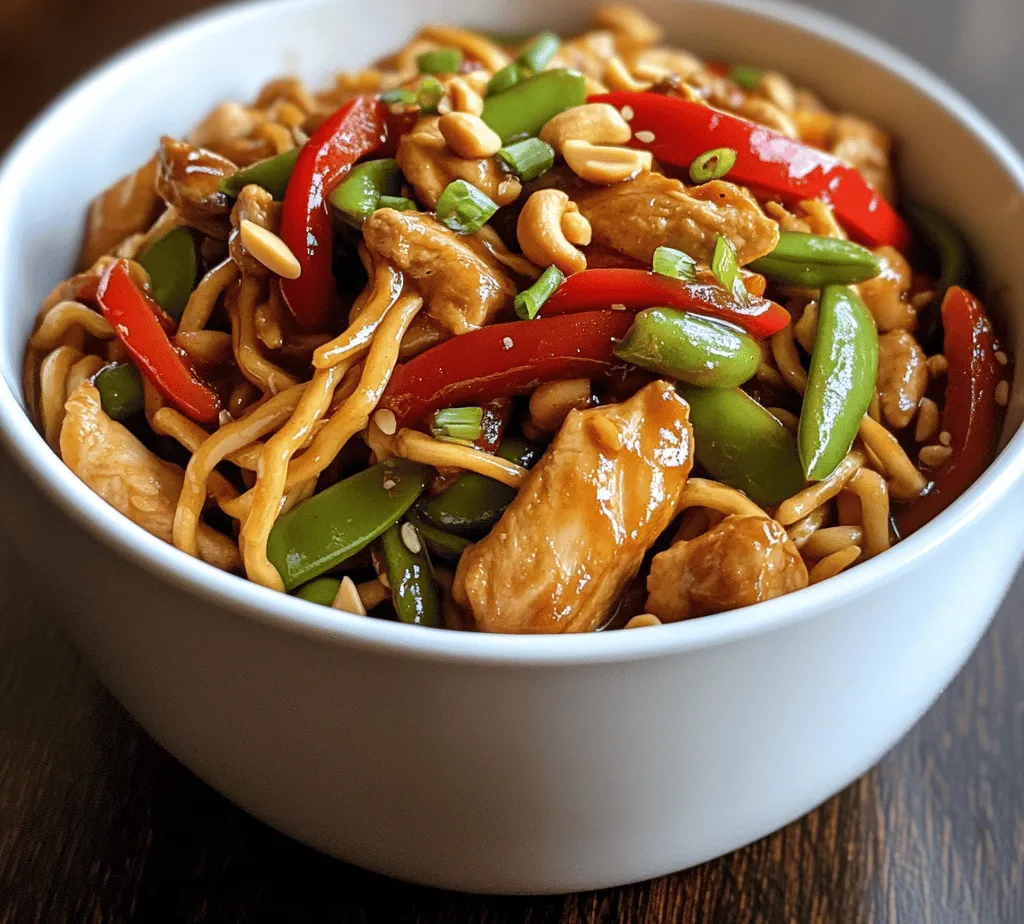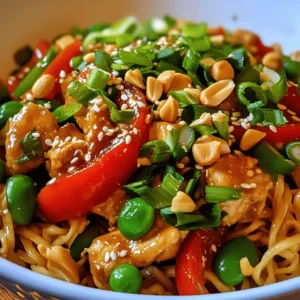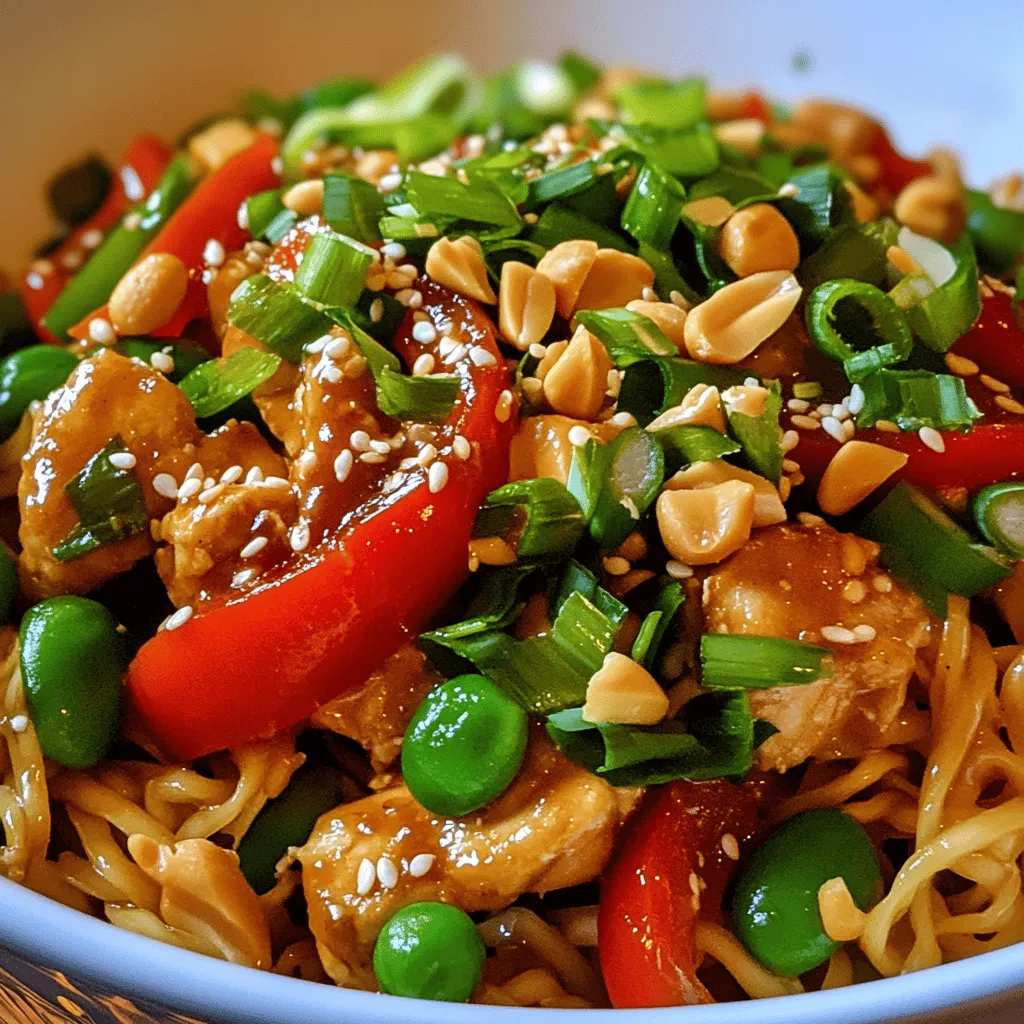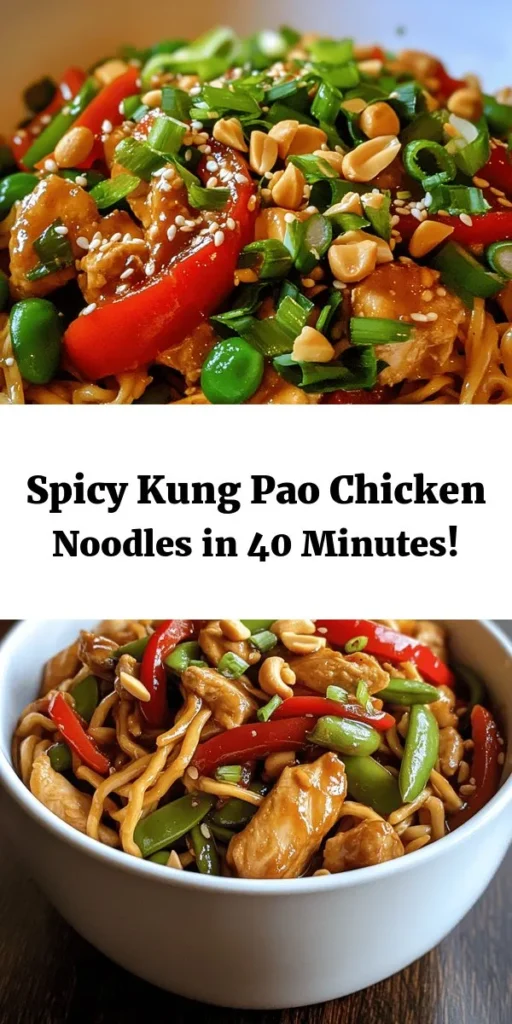Introduction
Kung Pao Chicken Noodles is a delightful fusion dish that combines the bold flavors of traditional Kung Pao Chicken with the comforting texture of noodles. This dish has its roots in Sichuan cuisine, where it has long been celebrated for its unique blend of spicy, sweet, and savory elements. The origins of Kung Pao Chicken date back to the late Qing Dynasty and are named after Ding Baozhen, a governor of Sichuan province who was known as “Kung Pao.” Over the years, this dish has transcended its regional origins, becoming a beloved staple in Chinese restaurants worldwide.
The appeal of Kung Pao Chicken Noodles lies in its versatility and the ease with which it can be prepared. Whether you are a busy professional looking for a quick weeknight dinner or a home cook seeking to impress guests with bold flavors, this dish delivers on all fronts. In this article, you will discover a detailed recipe that breaks down each component of this satisfying meal, along with essential cooking techniques that will elevate your culinary skills.
Understanding Kung Pao Chicken Noodles
At its core, Kung Pao Chicken Noodles consists of four main components: tender chicken, vibrant vegetables, chewy noodles, and a rich, flavorful sauce. Each element plays a crucial role in creating the dish’s signature taste and texture.
Components of the Dish
1. Chicken: Traditionally, boneless chicken thighs are preferred for their juiciness and flavor, but chicken breasts can also be used for a leaner option. The chicken is typically marinated to enhance its taste and tenderness before being stir-fried.
2. Vegetables: Fresh vegetables are a vital part of this dish. Common choices include bell peppers, zucchini, and green onions, which not only add color but also contribute crunch and a fresh taste that balances the richness of the chicken and sauce.
3. Noodles: The type of noodles you choose can significantly affect the dish’s overall texture. Egg noodles provide a hearty bite, while rice noodles offer a lighter alternative. The key is to cook the noodles to the right consistency, ensuring they are perfectly tender without becoming mushy.
4. Sauce: The sauce is where the magic happens. A combination of hoisin sauce, soy sauce, rice vinegar, and chili paste creates a harmonious blend of sweet, sour, and spicy flavors. This sauce brings all the elements of the dish together, coating the chicken and vegetables with a delicious glaze.
Flavor Fusion
The harmony of flavors in Kung Pao Chicken Noodles is what makes it so appealing. The sweetness of hoisin sauce complements the heat from chili paste, while the umami notes from soy sauce create a depth of flavor that is irresistible. This balance of sweet, spicy, and savory, combined with the varying textures of the ingredients, makes each bite a delightful experience.
Cultural Significance
Kung Pao Chicken holds a special place in Chinese cuisine, not only for its rich history but also for its representation of the culinary innovation that occurs within the country’s diverse food culture. It exemplifies the skillful use of ingredients to create robust flavors and is often considered a hallmark of Chinese cooking. By incorporating noodles into this beloved dish, Kung Pao Chicken Noodles brings a modern twist that appeals to contemporary palates while honoring its traditional roots.
Ingredients Breakdown
To prepare a delicious batch of Kung Pao Chicken Noodles, you will need the following ingredients:
Chicken Marinade
– Soy Sauce: This staple ingredient adds depth and umami flavor to the chicken.
– Rice Vinegar: Provides acidity that brightens the dish and balances the flavors.
– Cornstarch: Helps to tenderize the chicken while creating a slight coating that seals in juices during cooking.
– Sesame Oil: Adds a rich, nutty flavor that complements the other ingredients.
Stir-Fry Elements
– Fresh Vegetables: Bell peppers, zucchini, and green onions are commonly used. They not only bring color and texture but also vital nutrients to the dish.
– Aromatics: Garlic and ginger are essential for building flavor. They infuse the oil with their fragrant oils, creating a flavorful base for the stir-fry.
The Sauce
– Hoisin Sauce: A sweet and tangy sauce that provides a rich flavor and glossy finish to the dish.
– Chili Paste: Adds heat to the dish. Adjust the amount based on your spice preference.
– Soy Sauce: Used again in the sauce to enhance the savory notes of the dish.
Preparation Steps
Marinating the Chicken
Marination is a crucial step in ensuring your chicken is flavorful and tender. Here’s how to effectively marinate the chicken for your Kung Pao Chicken Noodles:
1. Choose Your Chicken: Start with boneless chicken thighs or breasts, cut into bite-sized pieces. Thighs are recommended for their moisture, but choose breasts if you prefer a leaner option.
2. Prepare the Marinade: In a medium bowl, combine 2 tablespoons of soy sauce, 1 tablespoon of rice vinegar, 1 tablespoon of cornstarch, and 1 teaspoon of sesame oil. Mix well to create a smooth marinade.
3. Marinate the Chicken: Add the chicken pieces to the marinade, making sure each piece is well coated. Cover the bowl with plastic wrap and refrigerate for at least 30 minutes. This allows the flavors to penetrate the meat and ensures a tender texture once cooked.
Cooking the Noodles
The noodles are a key component of this dish. Here are steps to cook them perfectly:
1. Choose Your Noodles: You can use egg noodles or rice noodles depending on your preference. Egg noodles will give a more substantial bite, while rice noodles are lighter and gluten-free.
2. Boil Water: Bring a large pot of salted water to a rolling boil. Adding salt enhances the flavor of the noodles as they cook.
3. Cook the Noodles: Add the noodles to the boiling water and cook according to the package instructions. Generally, egg noodles take about 5-7 minutes, while rice noodles may require 3-5 minutes. Stir occasionally to prevent clumping.
4. Drain and Rinse: Once cooked, drain the noodles in a colander and rinse them under cold water. This stops the cooking process and helps prevent them from sticking together.
5. Toss with Oil: To further prevent sticking, toss the rinsed noodles with a drizzle of sesame oil or vegetable oil. This adds flavor and keeps them separated until you’re ready to stir-fry.
By following these preparation steps, you will lay a strong foundation for creating a delicious plate of Kung Pao Chicken Noodles. In the next part of this article, we will explore the cooking process, including stir-frying the marinated chicken and vegetables, and combining everything with the flavorful sauce. Stay tuned for a culinary journey that will elevate your home cooking!

Making the Sauce
The sauce is one of the defining elements of Kung Pao Chicken Noodles, providing depth and flavor that ties the dish together. To create a balanced and delicious sauce, you’ll need a few essential ingredients that are staples in stir-fry cuisine.
Ingredients for the Sauce:
– 3 tablespoons soy sauce (light)
– 1 tablespoon soy sauce (dark)
– 1 tablespoon Chinese rice vinegar
– 1 tablespoon sesame oil
– 1 tablespoon sugar (or honey for a natural sweetener)
– 1 teaspoon cornstarch (mixed with 2 tablespoons of cold water to create a slurry)
– 1 teaspoon Sichuan peppercorns (optional, for authentic flavor)
– 1-2 tablespoons of chili paste or sauce (adjust based on your spice preference)
Creating Your Sauce:
1. In a small bowl, combine the light and dark soy sauces, rice vinegar, sesame oil, and sugar. Stir until the sugar is dissolved.
2. If you’re a fan of heat, add chili paste or sauce to the mixture. Start with one tablespoon and increase according to your taste.
3. To thicken the sauce slightly and give it a glossy finish, incorporate the cornstarch slurry. Mix thoroughly to ensure there are no lumps.
4. If using Sichuan peppercorns, you can either grind them into a fine powder or add them whole for a more intense flavor.
Tips for Adjusting Spice Levels and Sweetness:
– For a milder sauce, reduce the amount of chili paste or opt for a milder variant like sweet chili sauce.
– If you prefer a sweeter sauce, increase the sugar or honey incrementally, tasting as you go to achieve your desired balance.
– For a tangier flavor, add a splash more of rice vinegar, which will also enhance the overall depth of the sauce.
Stir-frying Techniques
Stir-frying is a technique that is all about speed and heat. To achieve perfectly cooked chicken and crisp vegetables, follow these essential tips:
Importance of High Heat and Quick Cooking:
– Use a wok or a large skillet with a flat bottom. This allows for even heat distribution and maximum surface area for stir-frying.
– Preheat your wok on high heat for at least 2-3 minutes before adding oil. You want the oil to shimmer but not smoke.
Cooking Chicken and Vegetables:
1. Chicken: Cut your chicken breast into bite-sized pieces to ensure even cooking. Marinate the chicken in a bit of soy sauce and cornstarch for 10-15 minutes before cooking; this not only enhances flavor but also helps create a slight crust when stir-fried.
2. Vegetables: Choose your vegetables wisely. Bell peppers, zucchini, snap peas, and carrots are excellent choices. Cut them into uniform sizes to ensure they cook evenly. Stir-fry the chicken until cooked through, then remove it from the wok and set it aside while you cook the vegetables.
3. Quick Cooking: Add the vegetables to the hot wok, starting with those that take longer to cook (like carrots) and finishing with those that cook quickly (like bell peppers). Stir-fry for about 2-3 minutes, keeping the heat high and the food moving to prevent burning.
Combining Everything
Bringing all components together at the right time is crucial for a delicious Kung Pao Chicken Noodle dish. Follow these steps:
1. Once your vegetables are nearly cooked to your liking, add the chicken back into the wok.
2. Pour the prepared sauce over the chicken and vegetables, making sure to stir thoroughly to coat everything evenly. The high heat will help the sauce thicken slightly, creating a nice glaze.
3. Add the cooked noodles to the wok, tossing everything together gently to ensure that the noodles are well coated with the sauce and all ingredients are mixed evenly.
4. Cook for an additional minute or two, allowing the noodles to absorb some of the flavors from the sauce.
Importance of Timing:
Timing is critical in stir-frying. Adding the noodles too early can cause them to become soggy, while adding them too late can lead to a lack of flavor absorption. Aim to have everything ready so you can combine them right after the vegetables and chicken are perfectly cooked.
Flavor Enhancements and Customizations
One of the great things about Kung Pao Chicken Noodles is the versatility of the dish. Here are some enhancements and customizations you can consider:
Suggestions for Additional Ingredients or Substitutions:
– Protein Alternatives: For a vegetarian version, replace the chicken with tofu or tempeh. Marinate and stir-fry the tofu until golden brown for the best texture.
– Noodle Variations: Swap traditional egg noodles for rice noodles or even zucchini noodles for a low-carb option.
Vegetable Options:
– Broccoli, bok choy, and mushrooms add great texture and flavor. Feel free to experiment with what you have on hand or what’s in season.
– Remember that the key is to maintain a balance of colors and textures to make your dish visually appealing and nutritious.
Adjusting Spice Levels:
– If serving to a group with varying spice tolerances, consider serving the chili paste or sauce on the side so everyone can customize their dish.
– For a milder flavor, use sweet soy sauce instead of regular soy sauce, which can help balance the heat.
Serving Suggestions
Presentation is key when serving Kung Pao Chicken Noodles. Here are some ideas to elevate your dish:
– Garnishing: Top your Kung Pao Chicken Noodles with chopped green onions, crushed peanuts, or sesame seeds for added texture and flavor.
– Side Dishes: Pair your dish with steamed dumplings, spring rolls, or a fresh cucumber salad to balance the meal.
– Beverage Pairings: A light beer or a refreshing iced tea complements the flavors well. For something non-alcoholic, consider a sparkling water with lime.
Nutritional Information
Understanding the nutritional content of your Kung Pao Chicken Noodles is important for maintaining a balanced diet. Here’s a general breakdown per serving:
– Calories: Approximately 450-500 calories (depending on portion size and ingredients)
– Protein: 30-35 grams (from chicken or tofu)
– Carbohydrates: 50-60 grams (from noodles and vegetables)
– Fat: 15-20 grams (from oils and peanuts)
Health Benefits of Ingredients:
– Lean Protein: Chicken or tofu provides essential amino acids necessary for muscle repair and growth.
– Vitamins and Minerals: The variety of vegetables contributes vitamins A, C, and K, as well as fiber, which supports overall health and digestion.
– Antioxidants: Ingredients like bell peppers and broccoli are rich in antioxidants, which help combat oxidative stress in the body.
Conclusion
Kung Pao Chicken Noodles is a delightful dish that brings together bold flavors, colorful ingredients, and satisfying textures. The joy of preparing this dish from scratch lies in customizing it to suit your taste preferences and dietary needs.
Whether you’re looking to spice up your weeknight dinners or impress guests with a homemade meal, this recipe is sure to become a family favorite. Experiment with different proteins, vegetables, and spice levels to make it uniquely yours. The satisfaction of creating a flavorful, nutritious meal in your kitchen is unmatched, and we encourage you to dive in and enjoy the process. Happy cooking!



